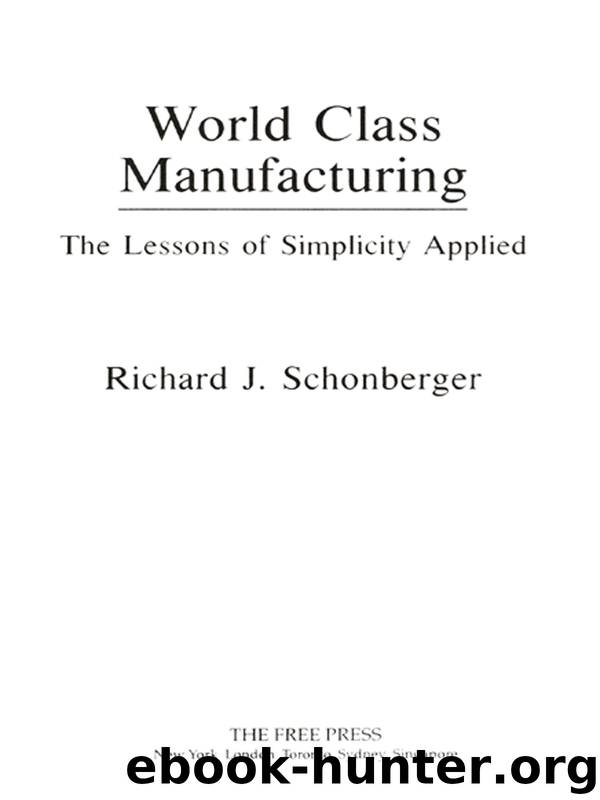World Class Manufacturing by Richard J. Schonberger

Author:Richard J. Schonberger
Language: eng
Format: epub
Tags: SOC035000
Publisher: The Free Press
Published: 1986-12-10T16:00:00+00:00
Chapter 7
Quality: Zeroing In
Quality is like art. Everyone’s for it, everyone recognizes it when they see it, but everyone defines it differently. Unlike art, nobody takes violent exception to someone else’s definition of quality.
All the definitions—fitness for use, meeting the customer’s requirements, right the first time, reduction of variability, and others—are just fine. They aren’t in conflict. We’ll take them all.
Quality: Competitive Weapon
Not long ago the first few Western companies took quality vows, then a few more, and before long whole bunches. Pledges to make quality “our basic business principle” or “the foundation for the management of our business” can have a hollow ring, like New Year’s resolutions. But the training that has followed the quality proclamations has been substantial. So have factory floor implementation efforts.
That is remarkable. Before the ferment of the 1980s, quality in Western industry had gone through thirty-five years of stagnation. Yes, we did change the name of the quality function: quality assurance department instead of quality control department. Slogans like “quality is everybody’s business” appeared, too. It was talk without action. In Japan there was talk and action. An American, Armand Feigenbaum, wrote a book called Total Quality Control, which proclaimed that all functions must unite in building quality in. Inspecting quality in by sorting the bad ones out—the “death certificate approach”—was outmoded. Large Japanese manufacturers seized upon the Feigenbaum message and even adopted the title of his book as the name for their quality movement: total quality control (TQC).
There were many minor players in Japan’s ascendency as an industrial power. I think there is no question about the star player: quality. The world’s consumers would pay more for a Sony television because they were convinced it was better. The scrap and rework avoidance and the simplifications that came from continual improvement of quality quickly drove costs down; then people elsewhere in the world could buy a superior Japanese product—and pay less for it.
It is my impression that in the 1950s top-level executives in Japan were serious enough about quality to demand concerted action from line and staff subordinates. In other words, quality was delegated. The results, after ten years or so, were astonishing growth in sales and productivity. That signaled the beginning of managing quality in. That is, quality came to be thought of as a strategic weapon, a matter for daily attention by senior management.
Quality Strategies
Competing with quality has alternate paths. David Garvin1 identifies eight dimensions of quality and gives a few examples of how certain of the eight may be pushed to the forefront to gain market share. The eight dimensions are (1) performance (acceleration for a car, brightness on a TV), (2) features (push-button windows), (3) reliability (failure rates), (4) conformance (lack of defects), (5) durability, (6) serviceability, (7) aesthetics, and (8) perceived quality.
One of Garvin’s examples is Steinway & Sons. A Steinway piano is known for even voicing, sweetness of its registers, duration of tone, long life, and finely polished wood. Those appear to be performance, durability, and aesthetics dimensions of quality; Steinway continues to enjoy its high reputation for them.
Download
This site does not store any files on its server. We only index and link to content provided by other sites. Please contact the content providers to delete copyright contents if any and email us, we'll remove relevant links or contents immediately.
Hit Refresh by Satya Nadella(8851)
The Compound Effect by Darren Hardy(8504)
Change Your Questions, Change Your Life by Marilee Adams(7368)
Nudge - Improving Decisions about Health, Wealth, and Happiness by Thaler Sunstein(7238)
The Black Swan by Nassim Nicholas Taleb(6761)
Deep Work by Cal Newport(6561)
Daring Greatly by Brene Brown(6221)
Rich Dad Poor Dad by Robert T. Kiyosaki(6173)
Principles: Life and Work by Ray Dalio(5953)
Man-made Catastrophes and Risk Information Concealment by Dmitry Chernov & Didier Sornette(5643)
Playing to Win_ How Strategy Really Works by A.G. Lafley & Roger L. Martin(5486)
Digital Minimalism by Cal Newport;(5388)
Big Magic: Creative Living Beyond Fear by Elizabeth Gilbert(5348)
The Myth of the Strong Leader by Archie Brown(5236)
The Slight Edge by Jeff Olson(5198)
Discipline Equals Freedom by Jocko Willink(5154)
The Motivation Myth by Jeff Haden(4996)
Stone's Rules by Roger Stone(4852)
The Laws of Human Nature by Robert Greene(4770)
